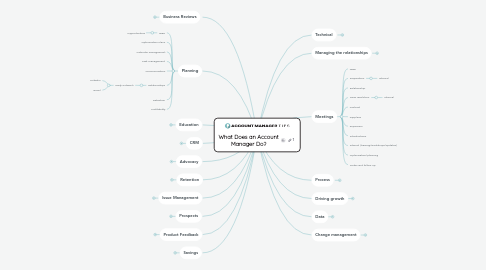What Does an Account Manager Do?
создатель Warwick Brown


1. Business Reviews
1.1. Preparation
1.1.1. Formatting
1.1.2. Running
1.1.3. Quality checking
1.2. Analysis
1.3. Recommendations
1.4. Setting meetings
1.5. Preparing agenda
1.6. follow up
2. Planning
2.1. QBR
2.1.1. Opportunities
2.2. Optimisation Plans
2.3. Calendar management
2.4. Task management
2.5. Communication
2.6. Relatoinships
2.6.1. Daily outreach
2.6.1.1. LinkedIn
2.6.1.2. Email
2.7. Retention
2.8. Profitability
3. Education
3.1. Internal
3.2. Business Engagement
3.3. Webinars
3.4. Supplier Days
3.5. User Forums / Lunch & Learn
3.6. Product info and updates
3.7. Best practice
4. CRM
4.1. admin
4.2. contact management
4.3. contract management
4.4. risk management
4.5. opportunity management
4.6. cases & incidents
4.7. meetings
4.8. training
4.9. content library
4.10. marketing campaigns
5. Advocacy
5.1. Customer service
5.2. Product
5.3. Finance
5.4. Customer Setup
5.5. Management
5.6. Technical
5.7. Global
6. Retention
6.1. Renewals
6.2. RFPs
6.3. Expansion
6.4. pro-formas
6.5. forecasting
6.6. gap analysis
7. Issue Management
7.1. Escalations
8. Prospects
8.1. support sales
8.1.1. Presentation
8.1.2. Trade Shows
9. Product Feedback
9.1. development
9.2. information
9.3. road maps
9.4. bugs
10. Savings
10.1. Processes
10.2. Suppliers
10.3. Product mix
10.4. Buyer behaviour
10.5. Forecasting
10.6. Benchmarking
10.7. Savings Plans
10.8. Standard vs customised
10.9. Fees (total cost of program)
10.10. Monitoring
10.11. Targets
10.11.1. Flexibility
11. Technical
11.1. Configuration
11.2. Integration
11.2.1. HR Feeds
11.2.2. Expense Management
11.2.3. SSO
11.3. Bugs
12. Managing the relationships
12.1. introducing other teams/stakeholders
12.2. Updating customer service with requirements
12.3. relationship mapping - who needs to know who
12.3.1. customer engagement plan
12.3.2. add contacts to CRM
12.4. Hosted events
12.5. Supplier relationships
12.6. Webinars
12.7. Focus Groups
12.8. first test customers/pilots
12.9. referees
12.10. surveys
12.11. Case studies
13. Meetings
13.1. QBR
13.2. Preparation
13.2.1. internal
13.3. Relationship
13.4. Issue resolution
13.4.1. internal
13.5. contract
13.6. suppliers
13.7. expansion
13.8. introductions
13.9. internal (training/workshops/updates)
13.10. Optimisation/planning
13.11. Notes and follow up
14. Process
14.1. Review & Design
14.2. Internal
15. Driving growth
15.1. Revenue
15.1.1. consulting
15.1.2. Suppliers
15.1.3. AM fees
15.1.4. reporting
15.1.5. What are the opportunities
15.2. Leakage
15.3. HAR
15.4. Expansion
15.5. Sourcing
15.6. Data consolidations
15.7. Research / News / Updates
15.8. Re-engagement
15.9. Macro/Micro economic forces
16. Data
16.1. Reporting
16.1.1. Trends
16.1.2. Insights
16.1.3. Actions
16.1.4. Convert to opportunity
16.1.5. What does it mean?
16.1.6. Context
16.2. Objectives
16.2.1. What do they want to achieve
16.2.2. Tracking & monitor
16.3. Quality
16.3.1. Consistency
16.3.2. Accuracy
16.4. Analysis
16.4.1. Deviants vs Compliant
